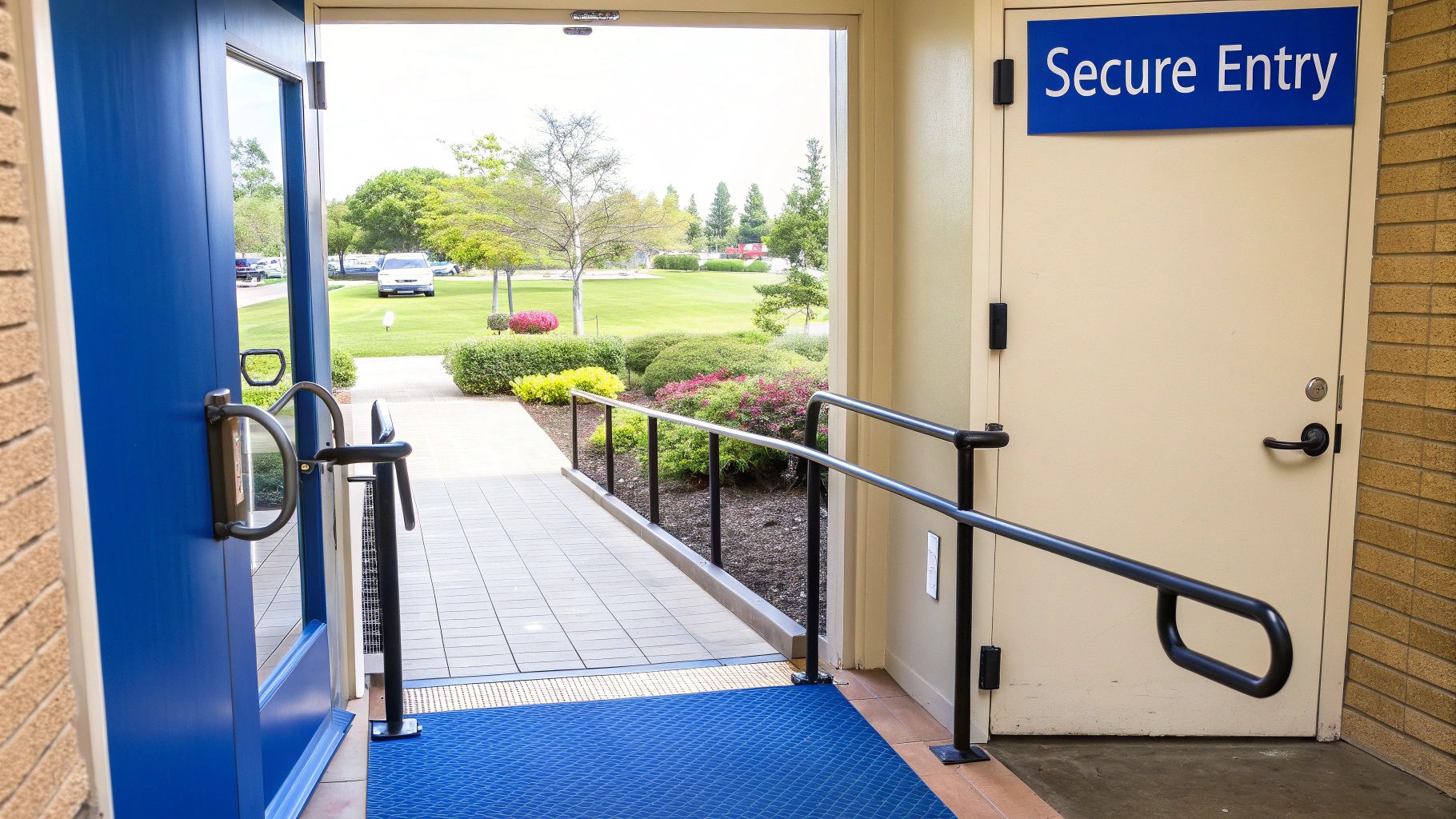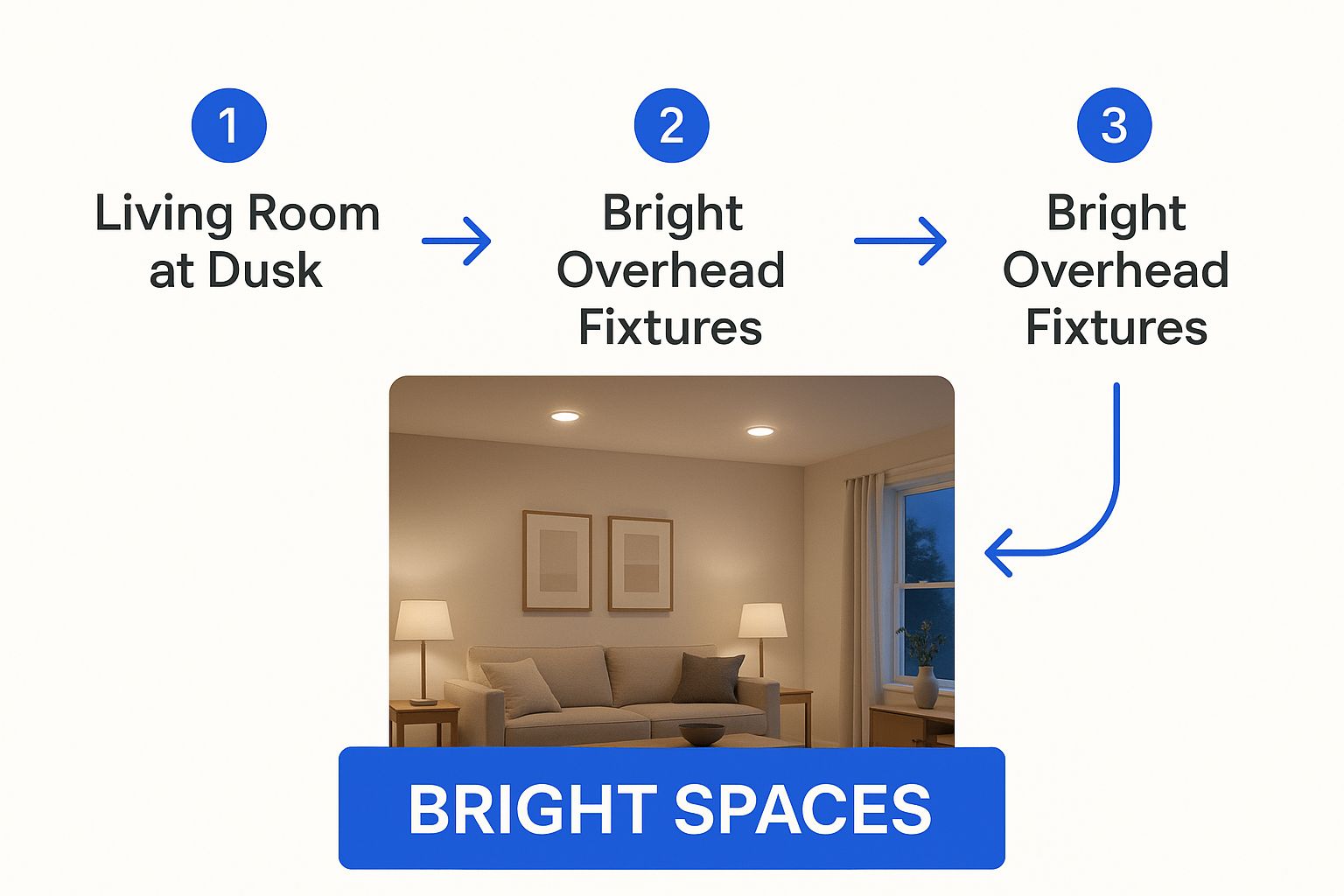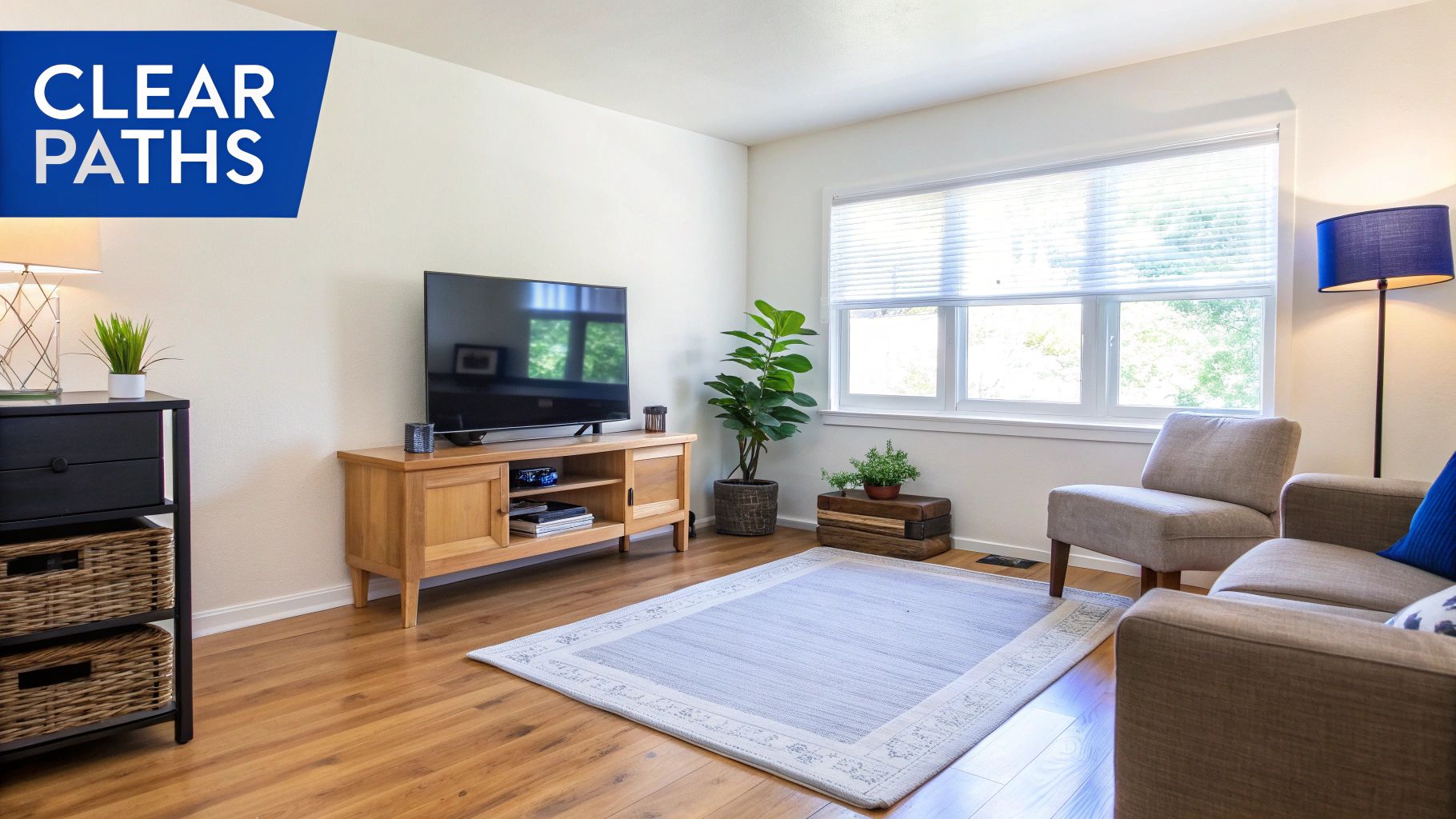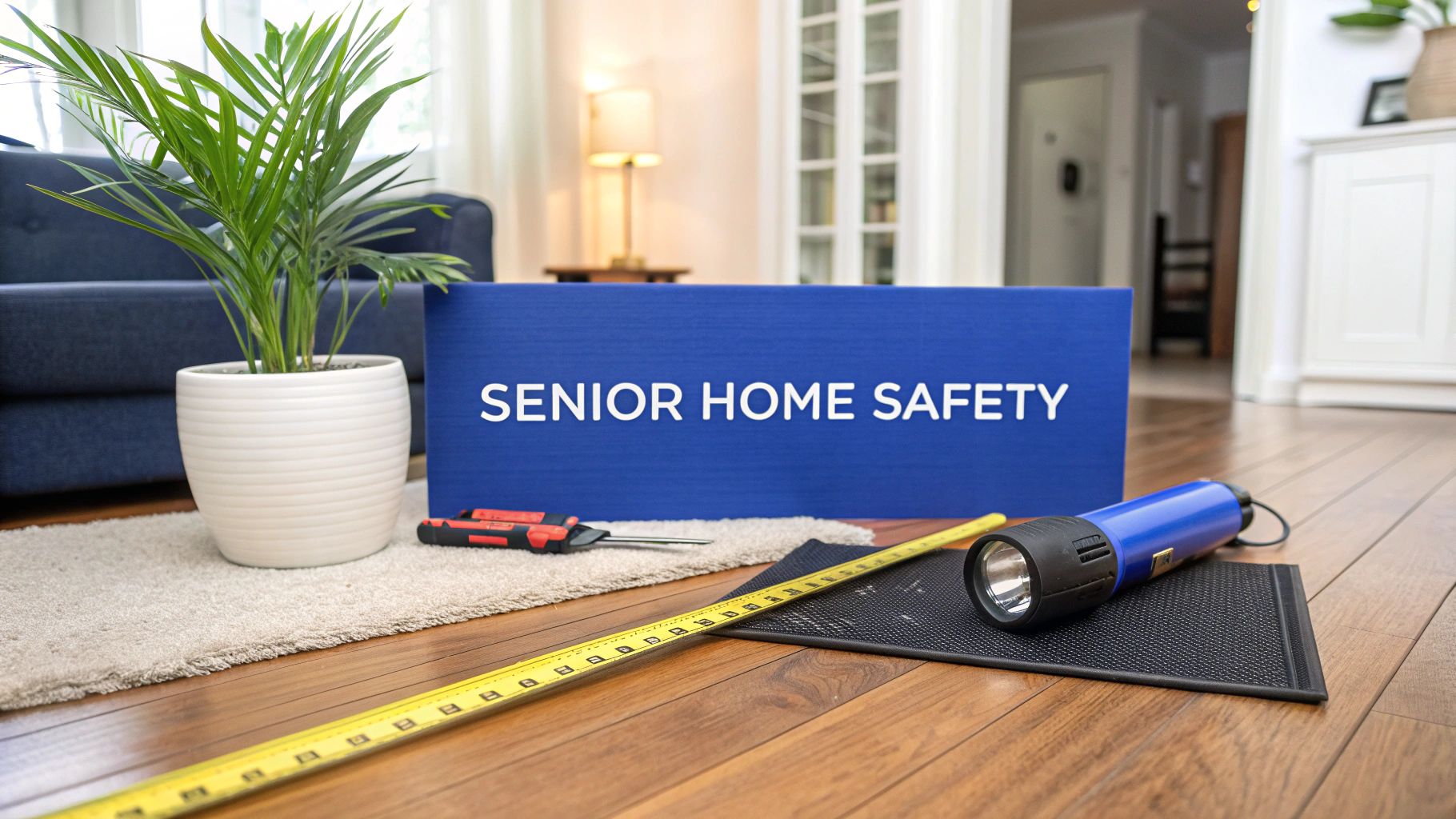A senior home safety assessment is much more than just a quick tidying up. It's a careful, proactive review of a living space to find and fix potential hazards before they can cause an injury. This systematic check is probably the most important thing you can do to support a loved one's wish to age in place safely, independently, and with dignity.
Why Home Safety Assessments Are So Important

When we think about a loved one getting older at home, our first thought is always about their well-being. But well-being isn't just about being happy—it's deeply tied to being safe. A home safety assessment for seniors takes you beyond generic advice and gives you a structured way to make a home as secure as it can be.
This process isn't about criticizing how someone keeps their house or forcing them to make changes they don't want. It’s really a team effort to spot the subtle risks that are so easy to miss in a place you've known for years. We're talking about the loose corner of a rug at the top of the stairs, the poor lighting in a hallway, or the cozy sofa that has become a real struggle to get out of.
From Reactive Crisis to Proactive Prevention
All too often, families only start thinking about home safety after an accident has already happened. This reactive approach puts you in crisis mode—dealing with a fall, a burn, or another injury that could have been prevented. The fallout can involve hospital stays, difficult rehab, and a lot of emotional stress, which can crush a senior's confidence and independence.
A proactive senior home safety assessment completely flips that script. When you spot and address risks ahead of time, you're not just preventing accidents; you're protecting their quality of life. This shift in mindset empowers everyone involved, creating a real sense of security and control.
The real goal of a home safety check is to ensure that a senior’s environment supports their independence, rather than limiting it. It's about enabling them to continue their daily routines with confidence and peace of mind.
The True Scope of a Home Assessment
A proper assessment is a comprehensive look at how a person actually lives in and moves through their environment. It’s not just a hunt for clutter. It’s a detailed evaluation that takes into account their mobility, their vision, and their daily habits. The focus is always on finding practical, real-world solutions that make life easier and safer.
This process involves looking at the home through a few different lenses to make sure nothing gets missed. The goal is to build a full picture of safety and support informed decision-making, which is a key part of quality care. If you're interested in the data behind this, you can explore the insights on safety measurement frameworks from this BMJ Open study.
To give you a better idea of what a professional looks for, here's a quick breakdown of the core focus areas in a typical assessment.
Core Focus Areas for a Home Safety Assessment
| Assessment Area | Common Hazards | Primary Safety Goal |
|---|---|---|
| Fall Risk Evaluation | Unsecured rugs, poor lighting, electrical cords, clutter in walkways | To identify and remove any and all tripping hazards. |
| Accessibility & Mobility | Narrow doorways, heavy doors, furniture blocking pathways | To ensure clear, wide paths for easy movement with or without a walker. |
| Kitchen & Fire Safety | Hard-to-reach items, malfunctioning smoke detectors, complex appliances | To prevent burns and injuries by making essentials accessible and ensuring safety devices work. |
| Bathroom Security | Slippery tubs and floors, lack of support for sitting/standing, dim lighting | To install grab bars, non-slip surfaces, and better lighting in this high-risk area. |
By methodically reviewing these areas, you get a complete picture of the home’s safety landscape. This gives you a clear, actionable roadmap for making meaningful improvements that will protect your loved one and honor their desire to stay right where they want to be: at home.
Of course. Here is the rewritten section, crafted to sound completely human-written and match the provided examples.
Getting Ready for a Collaborative Home Walkthrough
A truly effective home safety assessment doesn't start the moment you walk through the door. It begins with a conversation—one grounded in trust and a shared goal. The real key is to position the whole process as a team effort to make life easier and safer, not as a nit-picky inspection of their home.
How you approach this conversation makes all the difference. Instead of showing up with a checklist and a critical eye, try starting with a cup of coffee at the kitchen table. Explain that you want to help them live comfortably and independently in the home they love for as long as possible. When you frame it this way, you turn what could be a stressful event into a positive, collaborative project.
Kicking Off the Conversation
You'll find that the most important insights come from just listening. A quick visual scan can't possibly uncover the near-misses or daily frustrations your loved one might not think to mention. These gentle questions can help you uncover hidden risks without making them feel like they're under a microscope.
- "Have any chores around the house started to feel a little harder to manage lately?"
- "I was just wondering, have you ever felt a bit wobbly or unsteady in a certain room or hallway?"
- "Is there anything you find yourself avoiding because it just seems like too much of a hassle or a risk?"
- "Does the lighting feel bright enough at night, especially when you get up to go to the bathroom?"
Questions like these open the door to their real, lived experience, shining a light on potential hazards you'd never spot on your own.
Your Assessment Toolkit
Once you've got them on board, it’s time to gather a few simple things for the walkthrough. Being prepared just makes everything go a lot smoother. You don’t need a lot of fancy equipment, just a few basics to help you document what you find.
- A notepad and pen: Perfect for jotting down observations and starting a running list of possible solutions.
- A smartphone: Pictures are worth a thousand words. A quick photo of a frayed rug or a high cabinet shelf is a great reminder when you’re planning fixes later.
- A measuring tape: You'll definitely need this for checking the width of doorways for walkers or the height of a toilet seat.
- A flashlight: A bright light is a must-have for seeing into those dark corners in closets, basements, and behind appliances.
Remember, this is a partnership. As you move through the house together, ask them to show you how they do things, like getting a bowl from a high shelf or rising from their favorite armchair. Seeing things in action is the most valuable "tool" you have.
This thoughtful preparation is the bedrock of a successful senior home safety assessment. It ensures that the changes you ultimately suggest are not just practical but are also welcomed and accepted. When your loved one feels like a partner in the process, they're much more likely to see the changes as tools for keeping their freedom, not as unwelcome limits.
Your Room-by-Room Guide to Spotting Hazards
Alright, let's get practical. A good senior home safety assessment is all about learning to see a familiar space with fresh eyes. You have to methodically walk through every room your loved one uses, looking past the everyday mess to find the specific risks that can cause a fall or injury.
We aren't just looking for "clutter." We're looking at how things can become dangerous. Think about how that beautiful area rug slides a little too easily on the hardwood floor, or how that comfy armchair has gotten so soft and low that getting out of it is a real struggle. Breaking the home down zone-by-zone is the best way to make sure nothing gets missed.
Entrances and Hallways
The safety journey begins the second someone walks through the door. Entrances, stairs, and hallways are major thoroughfares where bad lighting and tripping hazards are incredibly common.
First, look at the lights. Is the path from the driveway to the living room well-lit, both outside and inside? A single flickering bulb or a dim fixture can cast shadows that play tricks on aging eyes. Picture your loved one coming home after sunset; a poorly lit entryway with a single, small step can easily cause a trip.
Now, let's look at the path itself.
- Walkways: Are they clear? The path needs to be wide enough for someone to get through easily, especially if they use a walker or a cane. Time to find a new home for that plant stand or the pile of mail that's narrowing the hall.
- Electrical Cords: Scan the floor for any cords snaking out from lamps or TVs. These are classic tripping hazards. They need to be secured tight against the baseboard with tape or a proper cord concealer.
- Stairways: Handrails are not optional. You need sturdy, easy-to-grip handrails securely fastened to the wall on both sides of the stairs. Check every step for loose carpet or cracked wood. Adding some non-slip treads is a simple fix that adds a ton of extra grip.
The statistics on falls are a stark reminder of why this matters so much. Studies show that falls are a huge problem for older adults, with 20% to 40% having one every year, depending on where they live. Even worse, having one fall makes another one much more likely. You can read a full study on fall prevalence and risk factors to get a deeper understanding.
Living Areas
The living room should be a place for relaxation, not an obstacle course. The big things to check here are the furniture, floors, and the overall flow of the room.
Imagine your parent trying to stand up from their favorite deep sofa after watching a movie. If they have to rock back and forth or grab a wobbly end table for support, that's a major red flag. Furniture should be firm and at a height that allows someone to sit and stand smoothly, without a struggle.
The goal is to create an environment that supports movement, not one that restricts it. Look for furniture that is sturdy and positioned to create clear, open pathways throughout the room.
Take a hard look at the flooring. Area rugs look great, but they are one of the most common reasons people trip.
- Flip a corner and check for a non-slip backing on every single rug.
- Make sure all the edges are lying perfectly flat. If a corner is curling up, use double-sided rug tape to secure it.
- Thick, high-pile, or shag rugs can be a real menace. They’re tough to navigate with a walker and can easily snag a foot.
This image really drives home how much of a difference good lighting can make in a living space.

As you can see, bright, well-placed lights get rid of dangerous shadows and make it so much easier to get around, especially at night.
The Kitchen
The kitchen is the heart of the home, but it’s also full of unique risks like burns, cuts, and slips. Our job is to make daily kitchen tasks safer and less physically demanding.
Think about something as simple as making a cup of coffee. Does your loved one have to pull out a shaky step stool to reach the mugs? Are their most-used pots and pans in a low cabinet that requires them to bend way down? Moving frequently used items to counter-height shelves—somewhere between their waist and shoulder—is a game-changing adjustment.
| Hazard | Safe Solution |
|---|---|
| Slippery Floors | Put a rubber-backed, non-slip mat in front of the sink. It'll catch any splashes and provide a secure place to stand. |
| Reaching for Items | Reorganize the cabinets. Heavy items and everyday dishes should be on shelves that are easy to get to. |
| Fire Risks | Test the smoke detector. For extra peace of mind, you might consider an automatic stove shut-off device. |
Also, do a quick check under the sink and around the fridge for any leaks. Even a tiny puddle on a tile floor is a serious slip hazard.
Bedrooms
A safe bedroom is key to getting a good night's sleep and, just as importantly, preventing falls during the night. The path from the bed to the bathroom is your top priority here.
Lighting is everything. There must be a lamp on the nightstand that's easy to reach and turn on from bed. Better yet, a motion-activated nightlight is a fantastic solution that automatically lights up the path to the bathroom the second their feet hit the floor.
The bed itself needs a quick check.
- Bed Height: Is it too high or too low? When they sit on the edge of the mattress, their feet should be flat on the floor with their knees bent at a 90-degree angle. A bed that's too high can cause a dangerous slide, while one that's too low is difficult to stand up from.
- Clear Path: The floor around the bed needs to be completely clear. No shoes, no clutter, no cords—especially in that direct path they walk in the middle of the night.
The Bathroom
Statistically, the bathroom is the most dangerous room in the house for seniors. It’s a perfect storm of water, slick surfaces, and hard fixtures.
Grab bars are the single most important safety upgrade you can make. It's critical to remember that towel racks are not grab bars; they will rip right out of the wall if someone puts their weight on them. You need professionally installed grab bars inside the shower and right next to the toilet.
Use a non-slip mat or adhesive strips on the floor of the tub or shower, and have a separate, rubber-backed bathmat on the floor outside of it. A shower chair or a transfer bench can also be a huge help, giving them a stable place to sit and reducing the risk of a fall while bathing. By carefully checking each of these zones, you can put together a safety plan that really works.
Putting Practical Home Safety Solutions into Action
Identifying the trouble spots during a senior home safety assessment is a great first step. But the real work—the part that truly makes a difference—is turning those observations into practical, life-enhancing changes. This is where you shift from simply spotting a problem to actively solving it, creating a safer space that still feels like home.
Every solution needs to be a thoughtful balance of safety, comfort, and your loved one's own preferences. The goal isn’t to turn a warm, familiar home into a sterile clinic. It’s about making smart, targeted adjustments that prevent accidents while respecting their dignity and personal style.
Tackling Fall and Tripping Hazards
During your walkthrough, you almost certainly spotted a few tripping hazards. The good news is that these are often the easiest and most impactful issues to fix, with solutions ranging from quick DIY adjustments to more permanent modifications.
Take that beautiful but slippery area rug in the living room, for example. You’ve got a few ways to handle it:
- Simple Fix: The fastest approach is to use high-quality, double-sided rug tape to secure all four corners and the edges. This stops the rug from sliding and prevents the edges from curling up.
- Better Solution: A much more effective option is to place a thick, non-slip pad underneath the entire rug. It adds a bit of cushion and provides far better grip than tape alone.
- Best Solution: In high-traffic areas like hallways, it's often best to remove area rugs completely. If a rug is a must-have, choose one with a very low pile and make sure it's anchored securely.
And what about those electrical or speaker cords snaking across the floor? The fix is refreshingly simple. Use wall-mounted cord concealers or tape them neatly along the baseboards to create a clear, trip-free path.
A huge part of this process is bringing your loved one into the conversation. Instead of declaring, "This rug has to go," try a softer approach. "I noticed this rug slips a bit. How would you feel about trying some non-slip tape to make it safer?" This kind of collaboration makes them a partner in the process.
Creating a Safer Bathroom
The bathroom is consistently one of the most high-risk areas in any home. With all the water and slick surfaces, targeted solutions aren't just a good idea—they're essential.
Let’s say the main concern is getting in and out of the tub or shower. Just throwing a bathmat down isn’t nearly enough.
- Essential Additions: The most critical update is installing professionally mounted grab bars. It’s vital to remember that towel racks are not a substitute; they aren't designed to hold a person's weight and will rip out of the wall. You need sturdy bars anchored directly into wall studs next to the toilet and both inside and outside the shower.
- In-Shower Support: A shower chair or a transfer bench gives your loved one a stable place to sit, which dramatically lowers the risk of a slip while bathing. It’s a simple change that empowers them to bathe independently and safely.
- Surface Grip: Apply non-slip adhesive strips or a high-quality rubber mat to the floor of the tub or shower itself. This provides crucial traction where it's needed most.
Improving Kitchen Safety and Accessibility
The kitchen is a hub of activity, but the right modifications can make daily tasks much less risky and strenuous. The key here is making sure the most frequently used items are easy to grab without a fuss.
If you see your loved one teetering on a wobbly stool to reach their favorite coffee mugs, that’s a clear sign for a change. Reorganize the cabinets so everyday dishes, glasses, and go-to food items are all on shelves between waist and shoulder height. This one small adjustment can completely eliminate the need for risky reaching or deep bending.
To help you visualize some common fixes, we've put together a quick table comparing common kitchen hazards with their solutions.
Common Hazards and Their Corresponding Solutions
This table breaks down some typical kitchen safety issues and offers a tiered approach to fixing them, from easy DIY adjustments to more involved modifications.
| Hazard | Low-Cost / DIY Solution | Recommended Modification |
|---|---|---|
| Slippery Floor Near Sink | Place a rubber-backed, non-slip mat where they usually stand to wash dishes. | Consider installing water-resistant, textured flooring for better grip throughout the kitchen. |
| Heavy Pots and Pans | Move the most-used heavy cookware to an easily accessible lower cabinet or a countertop rack. | Install pull-out shelving in lower cabinets to bring items forward, reducing deep bending. |
| Poor Lighting Over Countertops | Install simple, plug-in under-cabinet LED light strips. They are inexpensive and easy to mount. | Have an electrician install permanent, hardwired under-cabinet lighting for bright, even task lighting. |
Thinking through these solutions really comes down to understanding a person's daily routine. The most effective safety improvements are the ones that fit seamlessly into how they already live. The right fix isn't just about removing a danger; it's about empowering your loved one to handle their daily tasks with confidence and ease.
For more personalized guidance on creating a safe home environment, consider reaching out to the experts at NJ Caregiving, who can help you find that perfect balance of safety and independence.
Using Technology to Enhance Home Safety

Beyond the essentials like grab bars and non-slip mats, today's technology offers a powerful layer of support for seniors living at home. These modern tools can significantly boost safety and empower independence, which brings invaluable peace of mind to family members.
These solutions range from simple, helpful gadgets to more advanced systems that monitor well-being without being intrusive.
The key is to see technology not as a replacement for human connection, but as a supplementary tool. Think of it as an extra set of eyes and ears, working quietly in the background to prevent common household accidents. For many families, incorporating these devices is the logical next step after a thorough senior home safety assessment.
Smart Devices for Everyday Assistance
Simple smart home technology can address many of the risks you might identify during a home walkthrough. I've found these devices are often surprisingly easy to install and can be controlled with voice commands, a smartphone, or even automated schedules. This makes them accessible even for loved ones who aren't particularly tech-savvy.
Here are a few practical examples I often recommend:
- Voice-Activated Lights: A simple command like, "Hey Google, turn on the hallway light," can prevent fumbling for a switch in the dark. This is incredibly useful for those nighttime trips to the bathroom, which is a common time for falls.
- Automatic Stove Shut-Off Devices: Honestly, these gadgets are a game-changer for fire safety. You can set them up to automatically turn off a stove or cooktop after a specific period of inactivity, stopping a forgotten pot from turning into a disaster.
- Digital Medication Dispensers: These devices are a huge help. They can be programmed to dispense the right pills at the right time, usually with an audible or visual alert. Some even send a notification to a family member's phone if a dose is missed.
These tools directly tackle everyday risks, giving seniors more control over their environment while cutting down on the physical effort needed for certain tasks.
Advanced Monitoring for Greater Peace of Mind
For a more comprehensive approach, passive monitoring systems offer a sophisticated way to keep tabs on a loved one’s well-being without using invasive cameras. These systems use a network of small, discreet sensors placed around the home to learn daily activity patterns.
Once the system understands the normal routine, it can detect things like:
- Unusual Inactivity: If your mom, who normally gets up at 7 a.m., hasn't left her bedroom by 10 a.m., the system can send you an alert.
- Potential Falls: Some advanced sensors can detect the sudden impact of a fall and automatically notify emergency contacts or services.
- Changes in Routine: The system might flag if someone has stopped opening the refrigerator or has started visiting the bathroom much more frequently than usual—subtle changes that could point to an underlying health issue.
The real power of these systems is their ability to provide proactive insights. They don't just react to emergencies; they help you spot subtle changes in behavior that might signal a developing problem long before it becomes a crisis.
Interestingly, technology is also empowering older adults to take part in their own safety assessments. Recent studies show that digital self-assessment tools can be quite effective for spotting home hazards. While they might not be as detailed as a professional evaluation for specific areas like bathrooms, they represent a huge step in enabling seniors to actively manage their own environments. You can read more about the findings on digital self-assessment tools to see how it works.
Integrating these technologies can truly transform a house into a supportive and secure home.
Common Questions After a Home Safety Walkthrough
Once you’ve done an initial walkthrough of your loved one's home, you'll probably find yourself with a list of new questions. That’s not just normal—it's a crucial part of the process. Moving from simply spotting hazards to actually putting solutions in place takes some careful thought. Let's tackle some of the most common questions we hear from families after they've completed a senior home safety assessment.
Getting these answers will give you the clarity you need to move forward with confidence. The goal, after all, is to create a safer space that supports your loved one’s independence, not one that feels restrictive or overly medical.
How Often Should We Reassess the Home?
A home safety assessment isn't a "one-and-done" task. People's health and mobility can change over time, and the home environment needs to adapt right along with them. It’s best to think of your assessment as a living document, not a final report.
As a general rule, it’s smart to do a full, detailed review at least once a year. However, certain life events should absolutely trigger an immediate reassessment.
- After a Health Change: Any new medical diagnosis, a recent stay in the hospital, or even a subtle decline in mobility or memory means it's time for a fresh look.
- Following a Fall: Any fall, even if it doesn't cause a serious injury, is a major red flag. It’s a clear sign that something in the home isn't working and needs to be fixed.
- With New Equipment: If your loved one starts using a walker, cane, or wheelchair, you need to re-evaluate the entire home to make sure it’s truly accessible for their new reality.
- Seasonally: Quick check-ins with the changing seasons are also wise. The low light of fall and winter can create new shadows and visibility issues, while ice and snow introduce obvious outdoor risks.
Staying proactive with these check-ins is the best way to ensure the home remains a safe, supportive place through all of life’s changes.
What if My Parent Resists Making Changes?
This is easily the most common and delicate challenge families run into. When a parent pushes back, it’s rarely about just being stubborn. It’s usually coming from a deep-seated fear of losing their independence or control over their own life. The best way forward is with empathy and collaboration.
Try to frame the changes not as restrictions, but as tools that will help preserve their independence and allow them to stay in their beloved home for years to come. Instead of just telling them what needs to be done, bring them into the conversation.
A simple shift in language can make all the difference. Instead of saying, "You need a grab bar here," try asking, "I was thinking a sturdy bar right here might make getting out of the shower feel a bit more secure. What do you think?"
This approach gives them a voice and a sense of control. Start with small, easy wins—like a new non-slip bath mat or a brighter lightbulb in a dark hallway—to show the immediate, positive impact. Sometimes, hearing the suggestion from a neutral third party, like their doctor or an occupational therapist, can also make a big difference.
Can I Do This Myself, or Do I Need a Professional?
You can absolutely conduct a very effective senior home safety assessment on your own, especially with a good checklist. As a family member, you have a huge advantage: you have firsthand knowledge of your loved one's daily routines, their specific struggles, and their personal habits—insights an outside professional might miss in a single visit.
However, bringing in an expert can be incredibly helpful in certain situations.
- Complex Health Issues: If your parent is managing complex medical conditions, a progressive disease like Parkinson's, or significant cognitive decline, a professional can offer specialized recommendations that are tailored to their specific needs.
- Major Modifications: Thinking about bigger projects? If you’re considering structural changes like widening doorways, building a ramp, or remodeling a bathroom, a Certified Aging-in-Place Specialist (CAPS) is essential.
- Professional Expertise: An occupational therapist (OT) is a master at analyzing the interplay between a person and their environment. They are trained to come up with creative, customized solutions you might never have considered.
Often, the best strategy is a hybrid approach. You can perform the initial walkthrough yourself to take care of the obvious fixes, and then bring in a professional to help fine-tune the plan and advise on any larger, more complex modifications.
At NJ Caregiving, we understand that making a home safe for a senior can feel overwhelming. Our compassionate, skilled team is dedicated to helping families in Princeton and Mercer County create living environments that are safe, comfortable, and promote independence. If you need expert guidance or in-home support, we're here to help. You can learn more about our personalized care services by visiting us at https://njcaregiving.com.



